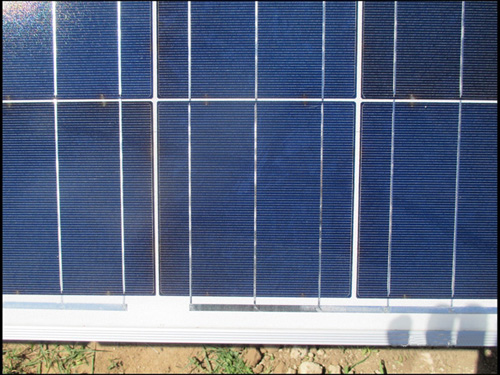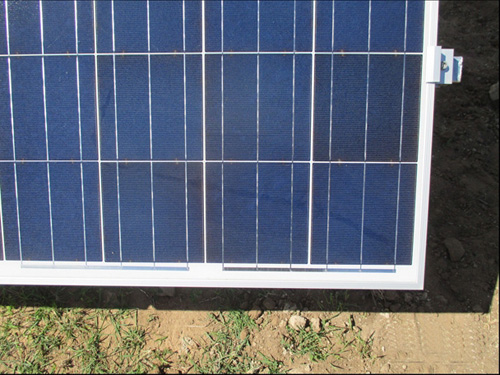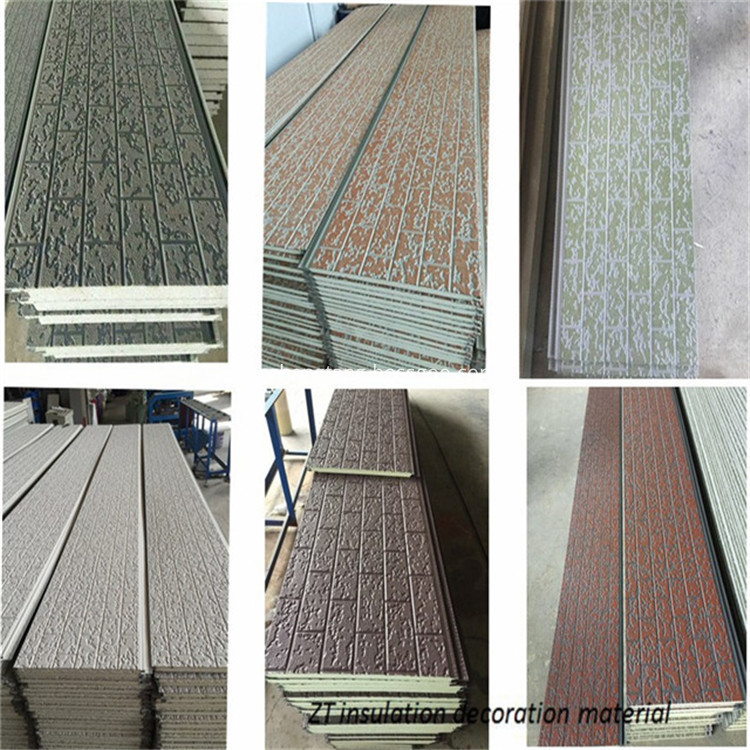In a certain location in northwestern China in September 2014, the construction site of a 20 MW photovoltaic power station was hot and the Chief Technical Officer Zhang Zhang took a deep breath: Immediately, the 10 MW installation will be successfully connected to the grid. This year's progress should not lag behind. . Suddenly, a call came in: “General Zhang, you come and see. The situation is urgent.†After driving to the scene, the situation at the scene made Zhang always stunned. I saw only a large area of ​​power station components with mottled patterns, like a snail crawling. . Zhang, the director of technology, himself pays great attention to the quality of the power station, and the components purchased by the world's leading brand manufacturers are all purchased from this batch of components. The quality of the components that have not yet been connected to the grid has caused such quality problems, and Zhang has been irritated. Further investigating the situation of the power station discovered that the problem was even more serious. A total of more than 6,000 pieces of components broke out in such a situation, that is, 32% of the components of the unfinished power station had such problems. After a successful power plant operation for 1 year, a rough estimate of 46% of the components occurred. Outbreaks of this kind of problem. (Above character names are fictitious, adapted from real cases)
Then, the problem came, how the snails broke out and what impact it would have on the operation of the power plant. Today we will explain the snail prints from the assembly production package.


The concept of snails in the usual sense: After a solar module has been exposed to light for a period of time (half a month or a few years), there is no need for the surface of the grid-connected components to begin to appear partially discolored, and a narrow, staggered dark line appears on the surface of the module. , resulting in a serious appearance. After the author's investigation of a number of photovoltaic power plants in China, we found that the area where the snail outbreak broke out was widespread (from Hainan to Xinjiang) and the temperature coefficient was quite different. The installed time (1 month to 25 years) had no obvious range, that is, Said that the outbreak of snails, runs through the entire life cycle of the plant. And within 25 years of component life, owners have to take a devious look at the risk of component outbursts.
Common snail texture pictures:

Almost all component manufacturers told the power station operator that snail lines have no effect on the power generation efficiency of the components. The reasons are basically similar: 1) The snail pattern is caused by slight reaction between silver and EVA on the surface of the cell grid line, which does not affect the gate line conduction and does not cause light to block, so it does not affect the power output of the module. 2) The snail pattern corresponds to the cell crack. If the crack does not cause the loss of the local area on the cell, it will not affect the power of the cell. Currently testing components that produce snail lines does not find significant reductions in component efficiency. Is this true? We need to analyze the packaging materials of the components and the possible relationship between snails.
The official name of EVA resin is ethylene-vinyl acetate copolymer. The content of vinyl acetate in EVA for photovoltaic modules is usually 28-33%. As a common chemical bond, ester has one of the most basic properties, and it breaks down into acid and alcohol in the presence of water.
The acetic acid that accumulates slowly in the photovoltaic module becomes the important cause of the quality problem of most photovoltaic modules. Japan's Chemitox laboratory immersed the cells in a certain concentration of dilute acetic acid solution to observe the change of the silver gate line, and found that acetic acid can gradually narrow the silver grid lines on the surface of the cell sheet. With the narrowing of the silver gate line, the power generation efficiency of the module gradually decreases. At present, most of the module factory's self-simulated snail pattern experiments use exposure experiments, connecting the positive and negative electrodes with diodes, and the experimental period rarely exceeds one year. The test using the fast simulation will simulate the actual power generation test with an external current in an environment of 85% humidity and 85°C and rarely exceed 1 month. Whether these experiments can truly explain the actual problem is inconclusive, and the fact that acetic acid corrodes the silver wire will eventually lead to a decrease in the power generation efficiency of photovoltaic cells. This is a definite phenomenon.
Whether EVA resin produces acetic acid and production methods, formulations have a great relationship. EVA is easily degraded during processing, so processing methods should be as slow as possible. The extrusion process of the screw extruder in the extrusion process is very important, if the degradation of the EVA resin takes place at this stage.
Some EVA film makers have made it cost-conscious to use a high-extrusion twin-screw extruder and use a metering pump to control the amount of extrusion. Extensive shearing in the extruder can be very risky. In other factories, the use of carts to pull large horses, single-screw extruder matching is too small, the speed of extrusion is too high, resulting in excessive shear of EVA resin, which is also one of the reasons for EVA degradation. A more reasonable approach is to use a large-diameter single-screw extruder, low-speed processing, so that the EVA resin melts evenly with heat, and the entire process is cut as little as possible. The formula of EVA itself is also very important. How to reduce the speed of acid production of EVA film is also one of the key technologies. Simply increasing the resistivity is only a surface phenomenon. Since the PID decay is also closely related to the acid content of the EVA film, the EVA film with excellent PID performance also performs excellently in terms of snail resistance.
The author consults Mr. Quan Yang, director of marketing at Haiyouwei Company. He said that snails and PID attenuation are very likely to be quality killers for photovoltaic power plants. Hai Youwei has never received any snail and PID decay complaints since its establishment. However, due to the fierce competition in the past few years, many component manufacturers often prefer to start with prices, and they are reluctant to adopt better quality products, even if they only have three cents per watt. It is very worried that the quality problems of photovoltaic power plants that are currently appearing on a large scale will eventually affect the development of the entire photovoltaic industry.
According to data released by the National Energy Administration, in the first half of 2014, China added 3.32 million kilowatts of grid-connected photovoltaic power. Compared with the same period of last year, the number of grid-connected photovoltaic power stations in Gansu, Xinjiang, and Qinghai increased by about 100%, reaching the maximum of 4.45 million kilowatts, 3.67 million kilowatts and 3.65 million kilowatts respectively. Since 2013, the scale of photovoltaic power station construction has been significantly expanded. However, a series of power station quality problems, especially component quality issues, have become increasingly prominent. High attenuation rate, snail pattern components and other frequent quality problems are spreading in large ground power stations in the west. Ji Zhenzeng, the vice president of the third-party testing agency Beijing Jianheng Certification Center, stated that “For 32 domestic provinces and cities, 425 of the capacity of 3.3 GW, including large-scale terrestrial power stations and distributed power stations, were detected and found that there are hot spots and attenuation in the photovoltaic modules. Cracks, snails and a series of problems." In a certain power station in Gansu Province, it was found that as much as 60% of the PV module power was significantly attenuated. Industry analysis shows that, in general, the average annual attenuation of the photoelectric conversion efficiency of the module should be controlled within 0.8%, but the attenuation of the above components has far exceeded this range.
As an important raw material for component quality, inferior EVA plays a role that cannot be ignored in the snail's pattern and power attenuation. In Shandong, reports of actual use of photovoltaic power plants such as Yancheng have shown that components using inferior EVA have been used for at least 3 months. Within the obvious power attenuation, a power plant in Yancheng within 1 year of power attenuation is as high as 60%. The author believes that the use of inferior EVA reduces the installed cost per watt, but it greatly reduces the service life of the power station, which leads to the attenuation of the power station when it does not reach the end of its service life, and even causes the power plant to be scrapped in advance. Investors in power stations should pay attention to the BOM list of components and reduce the cost of electricity from the actual life span of the components.
Crude Brick Texture Pu Sandwich Panels

Rich selection of textures and colors meet different decoration requirements, giving the city and the buildings a new look.
The PU foam is the most advanced and eco-friendly insulation material in the world. With the help of the back aluminum foil, the thermal preservation effect achieves the best.
The unique structure prevents the heat loss in winter. Meanwhile it reduces the heat of the summer sunshine.
Aceta paintcoat and flurocarbon paint of weather resistance performance are applied on surface of wall panel. It is reserved with superior self-cleaning, weather resistance, corrosion resistance and acid& alkali resistance performance.
Light weight with 3.7Kgs/m2 makes the installation easy.
The installation process is clean and tidy without any noise and dust, construction waste.
Different selections of accessories meet different effects.
High quality and stable performance: Manufactured in CNC automation production line, the product pass rate can reach 99.9% with stable chemical structure and physical structure.
Crude Brick Texture PU Sandwich Panels
Exterior Wall Panels,Insulation Metal Boards,Decorative Embossed Sandwich Panels,Crude Brick Texture Pu Sandwich Panels
Jinan Zhengtang Insulation Decoration Material Co.Ltd , https://www.ztwallsiding.com
